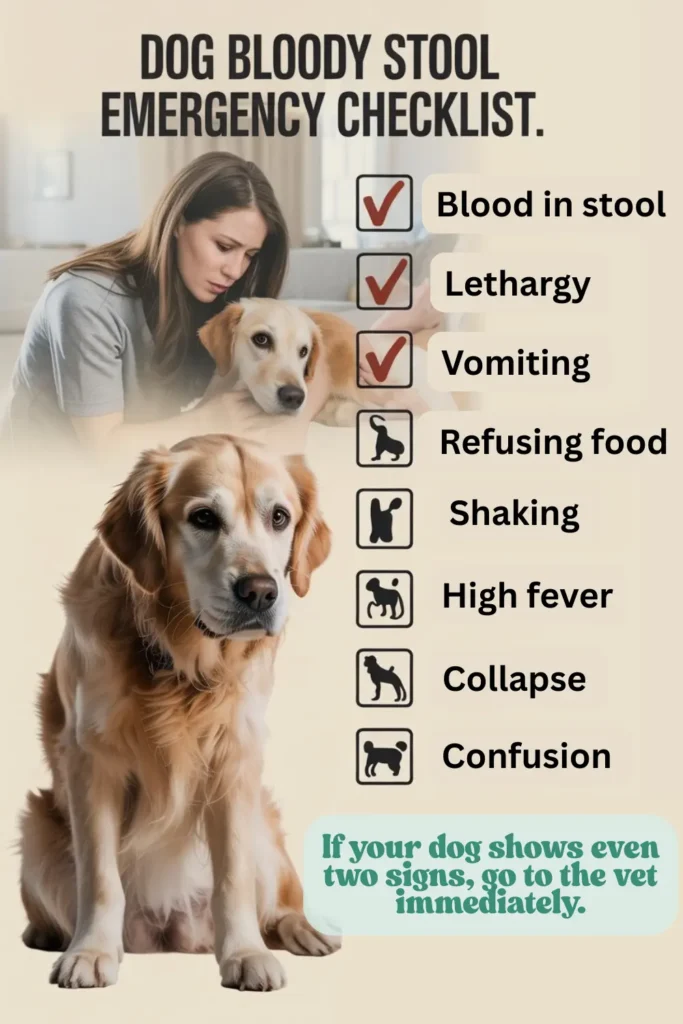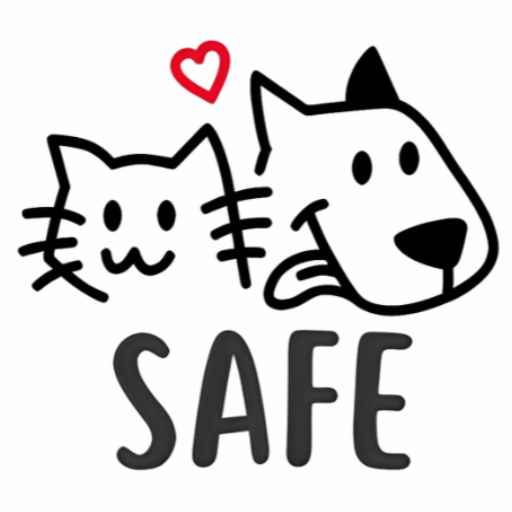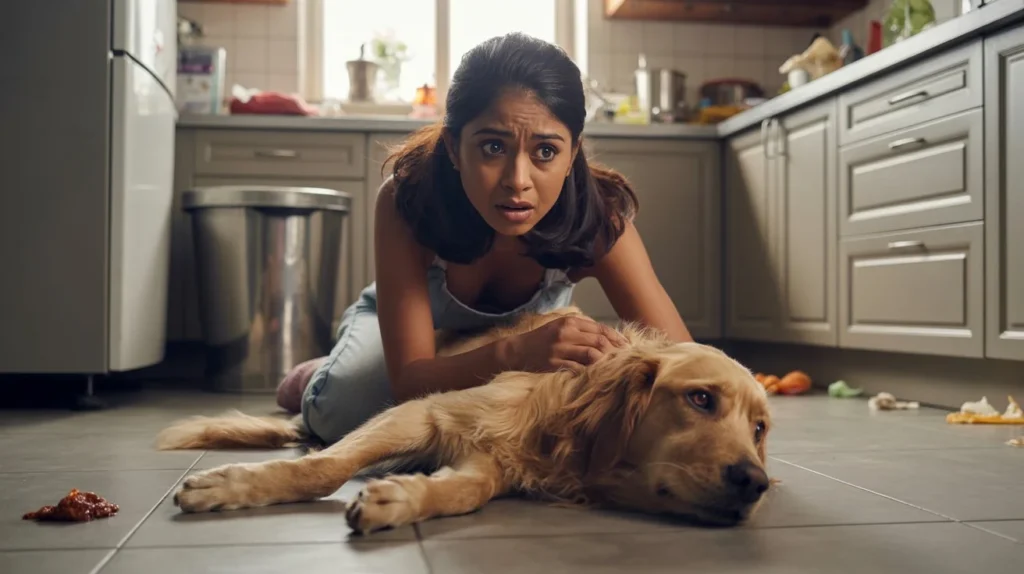The first time I saw blood in my dog’s stool, I got really scared. My heart was beating fast, and I didn’t know what to do. I had seen stomach problems before, but this looked worse. Later, I found out it was food poisoning in dogs: bloody stool can be a big warning sign. In this guide, I’ll share what I learned—how bad food, like trash or old treats, can lead to things like dog bloody diarrhoea from bad food or even hemorrhagic gastroenteritis in dogs. You’ll also learn how to tell when bloody stool is an emergency, and what to do if it happens.
Can Food Poisoning Cause Bloody Stool in Dogs?
The short answer? Yes, food poisoning can cause bloody stool in dogs. I found this out the hard way. One morning, I noticed my dog acting a little off—low energy, didn’t want breakfast, and then came the diarrhea. But what truly shook me was the streaks of blood. My heart sank. I later learned it was because he’d gotten into the kitchen trash and eaten spoiled leftovers.
Dogs are curious. They’ll sniff out anything—from expired dog food at the back of the pantry to table scraps you thought were safe. Unfortunately, even a quick bite of moldy bread or rotting meat can upset their stomach and lead to dog bloody diarrhoea from bad food.
So, if your dog recently raided the garbage or had access to spoiled food, and now there’s blood in their stool, it’s time to take it seriously. Spoiled or contaminated food irritates the digestive tract, which can lead to inflammation, diarrhea, and sometimes bleeding. That’s your dog’s gut waving a red flag—literally.
Think about it like this: if we eat something bad, we get a stomachache. But dogs can’t explain what they feel. Blood in their poop might be the only clue they’re in trouble. And just like with us, early action matters.
Severe Food Poisoning Symptoms in Dogs
Sometimes, the signs get worse. I saw blood in my dog’s poop one time. That’s when we rushed to the vet.
Here are the serious signs:
- Bloody stool – You may see red or dark poop. This is very bad.
- High fever – Your dog may feel hot or act shaky.
- Collapse – If your dog falls over or cannot get up, it’s an emergency.
- Neurological signs – Shaking, confusion, or odd behaviour means the brain is affected.
If your dog ate spoiled food, mouldy meat, or old scraps, and now shows these signs, call your vet right away. Don’t wait.
Understanding Hemorrhagic Gastroenteritis (HGE)
The first time I heard about hemorrhagic gastroenteritis in dogs, I was shocked. It sounded scary—and it was. My dog had bad diarrhea with blood, and I didn’t know what was going on. He had gotten into old food from the fridge. Just a few bites, but it hit hard. That’s how I learned about HGE.

What Is HGE and How Is It Linked to Bad Food?
HGE is when a dog’s belly gets very upset. The gut swells and leaks blood. It can happen fast and look a lot like food poisoning in dogs. The cause isn’t always clear. But often, it’s something they ate—like spoiled food, trash, or table scraps.
Symptoms Specific to HGE
Here’s what I noticed: My dog had sudden, bloody diarrhea. Not just a little red—there was a lot. He threw up, too. He looked weak and didn’t want to move. I rushed him to the vet.
Signs of HGE include:
- Bright red or dark bloody poop
- Vomiting (sometimes with blood)
- Tiredness or shaking
- Not eating or drinking
How Is It Different from Mild Food Poisoning?
Mild food poisoning in dogs can cause runny poop, maybe some throwing up. But they still drink water and act okay between bathroom trips.
HGE is different. It hits hard and fast. The blood in the poop is clear. Your dog may stop drinking and start shaking. It’s not just an upset tummy—it’s a red flag.
My Personal Experience with HGE
I’ll never forget the panic I felt. It started after my dog chewed on old leftovers from the counter. Hours later, he had red diarrhea and wouldn’t get up. I wrapped him in a blanket and took him straight to the vet. He stayed there for two days. The vet said it was a good thing I didn’t wait.
Now, I keep trash out of reach. I check dog food dates. I don’t feed table scraps, no matter how much he begs.
Blood in Dog Stool After Eating – When to Worry
Seeing blood in dog stool after eating is scary. I’ve been there, staring at the red streaks in shock. Your brain goes blank, then fills with worry. Is it serious? Did they just eat something weird? Is it an emergency?
Here’s what I learned: fresh blood usually looks bright red. It might be on the outside of the poop. That often means the problem is in the lower gut, like the colon. Digested blood is darker—almost black or like coffee grounds. That means the bleeding may be higher up, like in the stomach or small intestine.
I once caught my dog licking a greasy paper towel from the garbage. That night, his stool was loose, red, and he didn’t want dinner. It happened fast. The next morning, we were at the vet.
When Bloody Stool Is an Emergency
Sometimes, a little red in the poop might just mean a small tummy issue. But other times, it means your dog is in real trouble. So, when is it an emergency?
Here’s a checklist I now live by—if your dog shows even two of these, go to the vet right away:
- Blood in stool – bright red or black
- Lethargy – dog seems weak or slow
- Vomiting – especially more than once
- Refusing to eat or drink
- Shaking or trembling
- High fever – feels hot to the touch
- Collapse or won’t stand
- Confused or acting oddly
I’ve learned that when bloody stool is an emergency, quick action can save your dog’s life. It’s not worth waiting or guessing. Dogs can go downhill fast.
One time, after eating old barbecue meat from a party plate, my dog was sick within hours. Diarrhea. Blood. He couldn’t stand. I rushed him in—and the vet said it was just in time.
Trust your gut. If something feels off, act fast.
Complications of Dog Food Poisoning
When a dog gets sick from eating bad food, it can cause more than just an upset stomach. Some problems can be dangerous if not treated fast. I’ve seen this with my own dog—and it was scary. One of the first big problems we faced was dehydration from dog food poisoning.
Dehydration from Dog Food Poisoning
When your dog has vomiting or diarrhea, they lose a lot of water. That’s what happened to my dog after he ate moldy meat from the trash. His poop was runny, and he kept throwing up. Soon, he looked tired and his eyes looked sunken. That’s how I knew he was dehydrated.
Dehydration from dog food poisoning makes dogs weak. You may notice dry gums, sticky saliva, or that your dog isn’t peeing much. If your dog won’t drink water, that’s a red flag. When this happened to us, the vet gave fluids under the skin to help fast.
At home, you can try small sips of water or offer plain chicken broth. Some dogs will drink more if you offer ice cubes. A bland food diet like rice and boiled chicken can also help once they stop vomiting. But if your dog still won’t drink or gets worse, it’s vet time.
📊 Quick Reference Table: Dog Food Poisoning Complications and Treatments
| Condition | Cause | Key Symptoms | When to See Vet | Treatment Options |
| Mild Food Poisoning | Spoiled food, garbage, toxic treats | Vomiting, loose stool, lethargy | If symptoms last >24 hours | Hydration, bland diet |
| Hemorrhagic Gastroenteritis (HGE) | Unknown, often triggered by food | Bloody diarrhea, vomiting, lethargy | Immediately | IV fluids, hospitalization |
| Sepsis | Severe infection from GI toxins | High fever, collapse, dark gums | Emergency | Antibiotics, intensive care |
| Dehydration | Prolonged vomiting/diarrhea | Sunken eyes, dry gums, weakness | If unable to drink fluids | Subcutaneous/IV fluids |
Sepsis from Food Poisoning in Dogs
Sepsis from food poisoning in dogs is a very serious problem. It can happen when the stomach or intestines get badly hurt by rotten food. The bad stuff (toxins or germs) can get into the blood. That’s what sepsis is—a whole-body infection. It spreads fast and can be deadly if not treated.
I’ve heard of dogs getting sepsis from food poisoning after eating spoiled meat or trash. They start with vomiting and bloody poop. But then, they get worse. They may stop moving, collapse, or feel very hot. My vet once told me, “If the gums look purple or dark and the dog can’t stand, get them to us now.”
Symptoms of sepsis include shaking, high fever, weak pulse, and very tired behavior. A dog might seem confused or unable to walk right. It’s not just a tummy bug at that point—it’s a full emergency.
Hospitalization and antibiotics are needed fast. Only a vet can treat this. If your dog ever looks this sick after eating bad food, don’t wait. We almost lost our dog once because we didn’t act fast enough.

We’re the dedicated team behind MyPawSafe.com, with over a decade of combined experience in veterinary care, pet emergency response, and animal behavior. While we prefer to let our work speak for itself, our mission is clear: to provide science-backed, vet-approved advice that helps pet owners prevent accidents and save lives.



